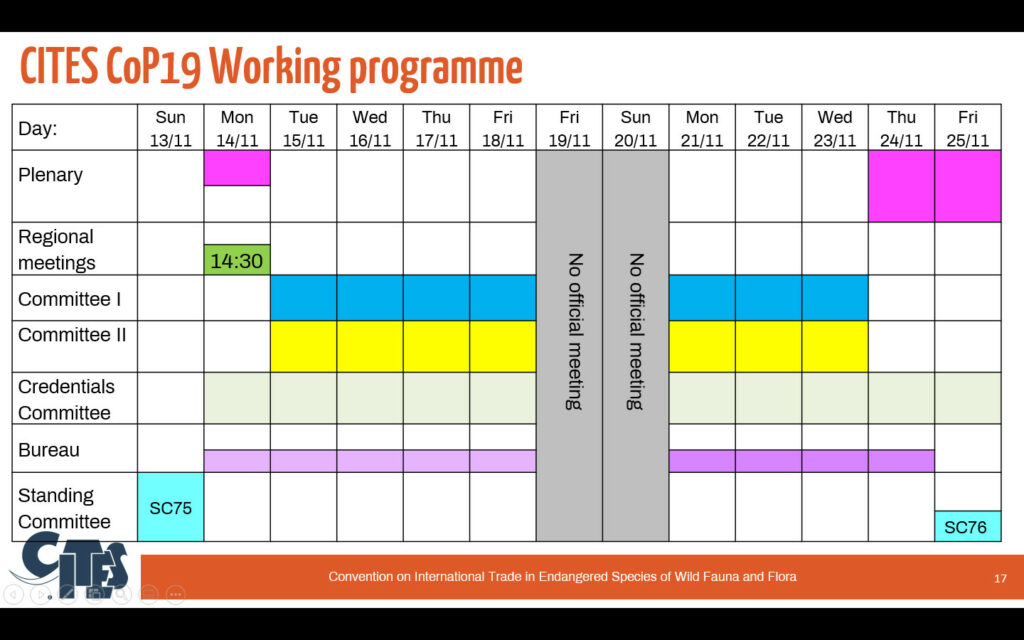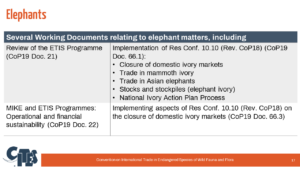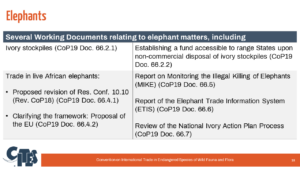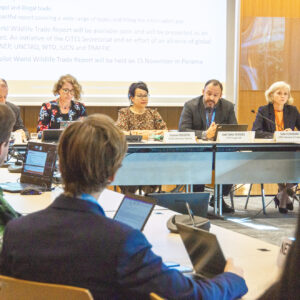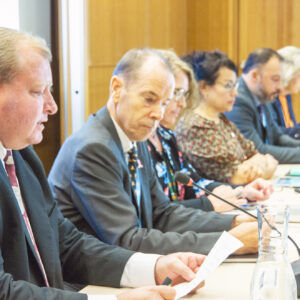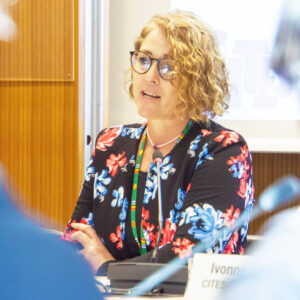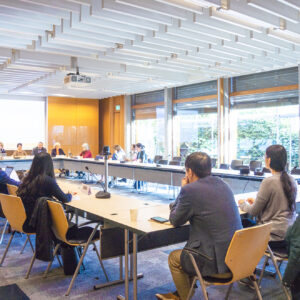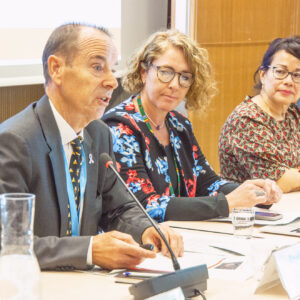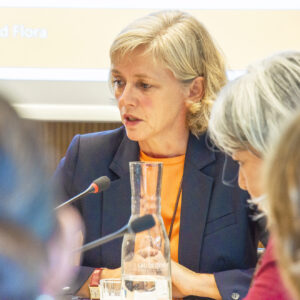Événement Conférence
Briefing on the World Wildlife Conference | 19th meeting of the Conference of the Parties to CITES
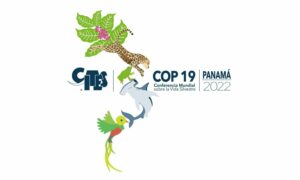
18 Oct 2022
09:30–11:00
Lieu: International Environment House II & Online | Webex
Organisation: Convention sur le commerce international des espèces de faune et de flore sauvages menacées d'extinction, Geneva Environment Network
A briefing focusing on the preparations for the upcoming 19th meeting of the Conference of the Parties to the Convention on International Trade in Endangered Species of Wild Fauna and Flora (CITES CoP19), or World Wildlife Conference, to be held in Panama, in November 2022, took place at the International Environment House and online, on Tuesday 18 October 2022.
About this Session
The upcoming 19th meeting of the Conference of the Parties to the Convention on International Trade in Endangered Species of Wild Fauna and Flora, or World Wildlife Conference, will take place in Panama, from 14 to 25 November 2022. Nearly 3,000 government officials, experts, representatives of local, national and international intergovernmental and non-governmental organizations technically qualified in protection, conservation or management of wild fauna and flora and visitors are expected to attend the meeting.
A total of 52 proposals and more than 100 working documents will be considered, debated and, if necessary, voted on by the 184 Parties to CITES. Amongst many other matters, the World Wildlife Conference will discuss the following issues:
- Strategic matters including the CITES Strategic Vision, the World Wildlife Trade Report, Engagements with indigenous people and local communities, CITES and Forests, zoonotic disease emergence associated with international wildlife trade, and CITES and gender.
- Interpretation and implementation matters, including national laws for the implementation of the Convention, compliance and enforcement matters, demand reduction to combat illegal wildlife trade, CITES permit issues and legal acquisition findings.
- Species specific matters that include a wide range of species from amphibians to big cats and elephants, marine and plant species.
- Matters relating to the maintenance of the Appendices that includes proposals by Parties to amend the criteria for listing species in the Appendices and proposals to clarify the use of reservations; and
- Proposals to amend the Appendices. Changes to trade regulations for nearly six hundred species of animals and plants are being proposed by Parties to the Convention. Most proposals are to bring new species under the purview of the Convention which may reflect the pressure being felt by nature as a result of human use of natural resources. Key species being proposed for inclusion in CITES are marine species (including sharks, sea cucumbers and ornamental fishes) and tropical timbers (including rosewoods, Brazil woods and mahoganies). On the other hand, some species are proposed for decreased protection under CITES as their populations in the wild have recovered (including the Puerto Rican boa and Aleutian cackling goose)
Decisions taken by parties at the CoP will come into force 90 days after the end of the meeting – on 23 February 2023. The objective of the Convention is that all international trade in CITES listed species is sustainable, legal and consistent with the long-term conservation of species and that CITES plays its part in halting biodiversity loss, ensuring its sustainable use, and achieving the 2030 Agenda for Sustainable Development.
You’ll be able to watch all the decisions of CoP19, steamed live from Panama, via the CITES.ORG website.
Summary: CITES CoP19 – the big issues
For more information, please consult the slides presented during the event.
Overview – CITES CoP19
Ivonne Higuero, Secretary-General, CITES Secretariat | Chair
CITES is looking forward to play an important role in ensuring that we can deal with the triple planetary crisis of biodiversity loss, pollution and climate change.
CITES is an international treaty, a legally binding international agreement signed by 183 parties plus one regional organization. Its ultimate aim is to regulate international trade of wild animals and plants so it does not threaten their survival in the wild.
The Secretariat is preparing not only for CoP19, but for its 50th anniversary next year. Part of the work is listing species across the three appendices:
- Appendix I. Prohibits the commercial trade of wild species listed.
- Appendix II. Allows international trade in species, but it is regulated very strictly by a permit system, which is agreed upon by all parties. This permitting system is in place for both importing and exporting parties.
- Appendix III. An appendix for when there are possible concerns by parties about a species being traded too much internationally, or concerns in the decrease of species populations, and as such are listed for monitoring.
The Conference of the Parties (CoP) is the decision-making body of CITES.
- Takes place every 2-3 years. CoP18 took place in Geneva (GEN Briefing available here).
- At least 2,000 participants are expected in CoP19.
- As the budget runs through a three-year period (2020-2022), a new resolution on the new budget from 2023-2025 will be needed.
- The agenda has more than 90 items and 127 working documents related to implementation, compliance and enforcement.
- The role of indigenous people and communities will be discussed. Youth delegates will also be involved.
This is a very strategic CoP set in motion all of the work we are doing: help halt biodiversity loss, conserve wildlife, regulate trade in wildlife, ensure that these species survive in the wild, and ensure that indigenous peoples and local communities who rely on these species can thrive and have their livelihoods, contribute to the economy. Having CITES is a very important part of living with nature and ensuring that we don’t suffer any more biodiversity loss.
Strategic Vision of CITES and Cooperation with organizations and Multilateral Environmental Agreements
Thea Carroll, Governing Bodies Unit, CITES Secretariat
Important Links and Documents
- Meetings webpage
- Agenda
- Working programme
- Daily schedule for CITES CoP19
- Proposals
- The Secretariat’s assessment of the proposals to amend Appendices I and II
- Panama — Host Country website
- Guide to the CoP decision making process
- CITES website
CoP19 Working Programme
- The meeting will start in plenary on 14 November, and will end in plenary on 24-25 November, when recommendations from Committees I & II will be considered for adoption.
- Majority of time will be spent in Committees I & II, where delegates and participants will discuss various working documents and proposals.
- A Standing Committee (SC) meeting will be on 13 & 25 November. A short SC meeting after the COP will be to discuss business going forward.
CITES Strategic Vision 2021-2030
- Adopted at CoP18, the vision agreed upon by CITES parties is that by 2030, all international trade in wild fauna and flora is legal and sustainable, towards long term conservation of species and contributing to halting biodiversity loss.
- The SC developed indicators to monitor whether parties are achieving the objectives, and the Secretary added a baseline to the document.
- The CoP will also consider a decision to map the Strategic Vision against the post-2020 Global Biodiversity Framework.
- Aims to improve the relationship with complementary international efforts through the consideration of a partnership strategy.
Cooperation with other biodiversity-related Conventions and organizations
- Aims to improve the relationship with complementary international efforts through the consideration of a partnership strategy.
- CoP18 adopted a Resolution on the Cooperation with IPBES.
- Draw off decisions relating to the proposed review of the recently launched the Thematic Assessment of the Sustainable Use of Wild Species by the Scientific Advisory Committees.
Elephants
- Elephant Trade Information System
- Reports to the COP on the implementation of resolution on trade in elephant specimens
- National Ivy Action Plan
Changes to the CITES Appendices
David Morgan, Scientific Unit, CITES Secretariat
Proposals to amend the Appendices
Depending on the different levels of protection afforded to different species according to conservation needs parties can submit proposals to adjust the level of protection at every meeting.
- At CoP19, there are 52 proposals. 39 are to increase protection, 12 are to decrease it, and 1 is neutral as it is a technical proposal.
- A wide variety of species are proposed: tree species for the timber trade, freshwater turtles (used a lot in pet trade and food), rhinoceroses, sharks, and African elephants.
Species
- African elephants
- With half a million left in Africa, some of the countries in the south of the continent want to be rewarded for increasing the number of species by allowing trade of certain products from elephants, such as ivory.
- Zimbabwe is putting forward a proposal to loosen the controls on trade in African elephant ivory to benefit from the use of this resource and to reinvest that money in the conservation of the species.
- Tense debates are expected at CoP19.
- Sea cucumber
- 4 species are already in the Appendices. They are overharvested as they are easily collected.
- Proposals to add three species currently not listed.
- This is a reference point for other marine species proposed for lifting, such as sharks. There is not as much research as there is for elephants.
- Timber species
- Used for timber around the world: construction tools, implements, joinery, furniture and flooring.
- In recent years, many more of the countries of origin where these trees are growing are turning to CITES to regulate the trade.
- 5 proposals to include new species. They cover around 150 species of precious wood.
- Aleutian cackling goose
- International trade has been prohibited years ago due to overhunting and overexploitation.
- Since then, countries have been able to increase the number of species, from a couple of hundreds in the 1960s to 162,000. Proposals for decreased proportion have been produced.
There’s a large suite of activities, and there is a bit of a struggle to keep up on the part of the Secretariat and the parties. This shows there’s a need and an interest to take action.
Wildlife trade and zoonotic diseases
What is the role for societies in helping to reduce the risk from future zoonotic disease emergence associated with international wildlife trade? We’ve seen one virus which has spread to humans from wild animals, and there are more lurking out there in reserve, particularly in bats. We need to be ready to address these consequences in future.
What could CITES do? Two approaches are proposed:
- Stepwise approach: a review of the state of things and look at our relationships with other organizations to see how they can be strengthened. Then, a proposal in 2025 for more concrete action.
- Immediate action: A group of countries is proposing that parties set up national CITES One Health panels, programs and plans. A body organized by the CITES secretariat to advise the countries on what sort of things they should be doing.
Enforcement issues – combating illegal wildlife trade
Ben Janse Van Rensburg, Enforcement Unit, CITES Secretariat
A few references to illegal trade in wildlife, wildlife crime and illegal trade in wildlife remains a global issue, and poses a big global challenge. A number of documents also discussed at COP that deals with enforcement issues and illegal wildlife trading.
Enforcement matters
- Scale up efforts to address illicit financial flows from wildlife crime. Parties must ensure that they have risk mitigation policies and strategies in place, because corruption continues to pose a challenge.
- Need to use forensic applications to the fullest extent possible to combat wildlife crime.
- Enforcement-related webpages: Enforcement, Enforcement focal points, Wildlife crime linked to the Internet, Wildlife forensics, Annual Illegal trade reports, and ICCWC
- Directory of laboratories that conduct wildlife forensic testing
- In terms of recommendations to be considered, CoP amendments to resolution CoP17.6 on prohibiting, preventing, detecting, and countering corruption and illicit financial flows are proposed.
Annual illegal trade reports
- This document provides information on the activities conducted regarding annual illegal trade reports submitted by Parties and regarding the implementation of decisions on this issue.
- As of June 2022, over 100,000 seizure records have been recorded in the CITES illegal trade database.
- With the UN Office on Drugs and Crime a report for CoP19 was prepared, providing an assessment of the annual illegal trade reports and the data submitted by Parties for the 2016 to 2020 period.
- There are amendments proposed that aim to promote the standardization of seizure data reporting and to facilitate the use of the standard reporting template.
Enforcement Issues to be discussed
- Wildlife crime enforcement support in Western Central Africa
- Task Force on Illegal Trading of CITES-listed Tree Species
- Totoaba
- Asian big cats (Felidae spp.)
- Pangolins (Manis spp.)
- Rhinoceroses (Rhinocerotidae spp.)
- Other enforcement related matters
International Consortium on Combating Wildlife Crime (ICCWC)
- Secretariat report on a broad range of activities conducted and tools developed under the auspices of ICCWC.
- Collaborative effort between the CITES Secretariat, INTERPOL, UNODC, the World Bank and the WCO.
- ICCWC continues to play a critical role in assisting Parties globally to combat wildlife crime using a coordinated and cohesive approach.
- ICCWC Vision 2030 – providing the roadmap for the work of the Consortium over the coming years – will be launched on the sidelines of CoP19.
Legal matters
Juan Carlos Vasquez, Legal Unit, CITES Secretariat
The 75th Standing Committee meeting, which takes place on 13 November 2022 will discuss important matters relating to compliance, mainly related to some of the countries of the parties from different continents.
Rules of Procedure
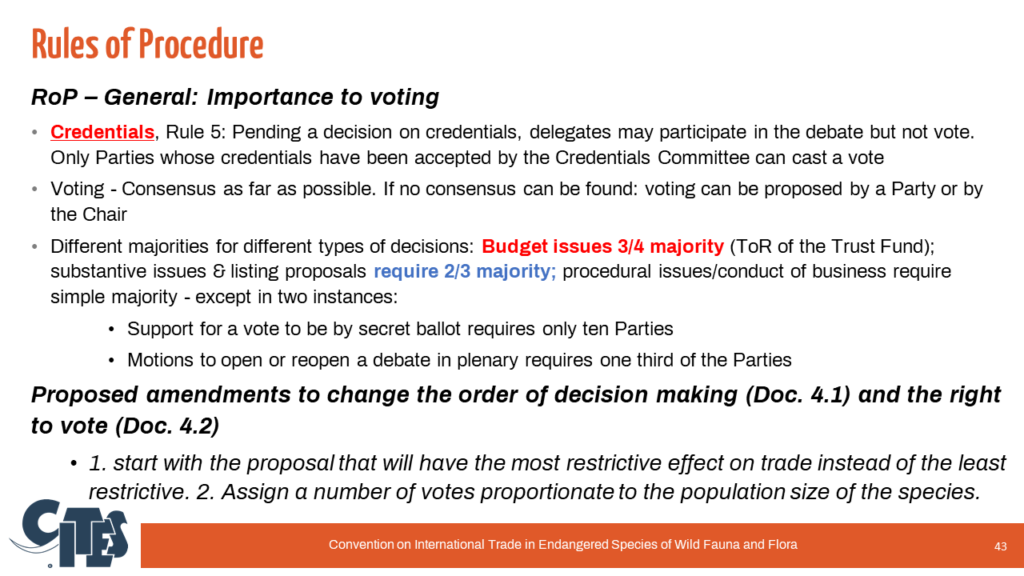
Proposed amendments to change the order of decision making (Doc. 4.1) and the right to vote (Doc. 4.2)
- The existing rules will apply until those rules are amended
- The parties are expected to find a way forward to avoid spending time on the first day discussing amendments to and also voting.
World Wildlife Trade Report
South Africa is suggesting to the other Parties some decisions to continue to have a periodic version of the World Wildlife Trade Report giving an accounting of the value of wildlife trade for the parties and the benefits to the national economies, the local communities, indigenous people that are benefiting from that trade, including:
- trends and patterns of trade in CITES listed species,
- economic value,
- conservation impacts,
- socio-economic benefits,
- linkages between legal and illegal trade.
IPLC and Livelihoods
Growing interest in livelihoods and rural community engagement to ensure that legal trade generates benefits to the livelihoods of those who live with wild animals and plants, and that their voices are heard in the decision-making processes.
- Chair of Standing Committee will introduce two documents:
- IPLC engagement
- CITES & livelihoods
- Document on Participatory Mechanism for Rural Communities
- CITES and Livelihoods Programme
National Legislation Project (NLP)
NLP assess the legislation of 184 parties to make sure it complies with minimum requirements for it to be implemented, since it is not a self-executing treaty:
- Introducing a new issue: exceptional circumstances impeding the normal functioning of CITES at the national level (such as natural disasters)
- Inviting the CoP to adopt a set of draft decisions
Compliance Matters
- Compliance matters – Includes an escalated procedure for timber in West Africa that involves 16 countries and is a quite innovative approach. The Conference of the Parties is invited to reflect on approaches to facilitate handling of the increasing number of cases.
- Compliance Assistance Programme (CAP) – CoP19 Doc. 30. A multidisciplinary program involving scientists, enforcement colleagues and the capacity building, outreach and project unit. The Parties are invited to adopt amendments to Resolution 14.3 on CITES compliance procedures which reflect the establishment of the CAP and draft decisions and to consider moving from national approaches to regional or supraregional ones.
Guidance on Legal Acquisition Findings
- Determined by legal acquisition findings, proof of origin, and legal origin of trade specimens.
- CITES is providing revised guidance, a rapid guide for verifying legality for CITES transactions.
Introduction from the Sea
At CoP18, Secretariat was mandated to monitor implementation of Resolution 14.6 on Introduction from the sea. Recent observation that CITES provisions regulating trade in listed marine species are not yet sufficiently understood
The Conference of the Parties is invited to consider renewing the mandate of the Secretariat to report on BBNJ negotiations and monitor implementation of Res. 14.6;
- mandating the Secretariat to approach and work with states most active in IFS trade, including common flag states;
- mandating the Standing Committee to review the 10 most frequently asked questions and responses.
Specimens produced through biotechnology
Amendment to Resolution Conf. 9.6 (Rev. CoP16) on Trade in readily recognizable parts and derivatives to the effect that specimens produced through biotechnology be regulated within the framework of the Convention
- The document is the definition for parts and derivatives in resolution 9.6. The working group created by the Standing Committee suggested to consider that all these specimens are produced in a lab through biotechnology that contain specimens, citizen ingredients.
Demand reduction and Domestic markets for frequently illegally traded specimens
- Trying to think outside the box, CITES is developing a guidance for parties that would like to adopt demand reduction strategies with a focus on evidence based for targeted species and also trying to focus on behavior change.
Jaguar
Jaguars will be the one of the most iconic species for the COP in Panama.
Communication concerning amendments to the Appendices
Parties appear to consider that changes to references to Resolutions contained in annotations are considered amendments and therefore ought to follow the procedure set out in Article XV;
- the communications made in response to Notification to the Parties No. 2019/052 are not reservations; and
- the scope and effect of reservations entered in relation to amendment of annotations should be clearly circumscribed.
The Conference of the Parties are invited to adopt the amendments to:
- Resolution Conf 11.21 (Rev. CoP18),
- Resolution Conf. 4.6 (Rev. CoP18),
- Resolution Conf. 4.25 (Rev. CoP18)
Capacity-building, access to funding and High-level event
Sofie Flensborg, Outreach and Projects Unit, CITES Secretariat
Capacity building
- Proposes a new resolution on capacity building. The work will report on the decisions that were made at the previous COP 39 to 46.
- Continued discussion on the capacity-building framework. The Standing Committee was invited to develop an integrated capacity building framework that would help assess the needs and provide a more coordinated capacity building where those needs were identified.
- The Standing Committee is proposing a new resolution on capacity building for adoption at this coming Conference and also proposing a continued discussion on integrated capacity building framework.
Access to funding
- Link CITES implementation with GEF GWP and Wildlife Conservation for Development Integrated Programme. Item 7.5, which is talking to this issue, is firstly linking the site’s implementation with the GEF and its new Wildlife Conservation for Development integrated program, where there are new opportunities to seek financing for implementation.
- Roundtable on sustainable financing for wildlife conservation. CITES will be reporting on this to the Conference of the Parties.
- Two additional proposals on access to funding for conservation
CITES & Gender
- Proposes a new resolution on gender and wildlife – decisions on a gender action plan. CITES’ Secretary General is the first woman to head this Secretariat.
- CITES needs an agenda item on citizens and genders, which is, the first time that we are addressing this so explicitly. The document proposes a new resolution on gender and wildlife, as well as some decisions that will encourage the establishment of gender action plans at the national level.
CITES Tree Species Programme
- Report on the outputs of the programme and its projects in 2017- 2022. Discussing and reporting on the results of the Citizens Businesses Program and the projects that have been carried out.
- The 20 projects that have been carried out over the period of this project, funded by the EU and about 20 projects have been implemented, producing a total of 80 technical reports, available on the CITES Trees Species Program website.
- Report on the lessons learned from the closing workshop. The document itself and the decisions contained in the document will propose a new phase or a new similar program for capacity building.
- Proposal for a new phase: CITES Programme on forests and tree species with three pillars with strong alignment with CITES mandates, capacity building, compliance efforts, engagement of rural communities as cross-cutting themes. CITES is looking to see if they can generate sufficient demand and support for continuing this work. A side event on this citizen forest will take place in the evening of 15 November.
UN World Wildlife Day
- WWD 2023 extra significance – 50th Anniversary of CITES
- WWD 2023 Theme: ‘Partnerships for wildlife conservation’. CITES will report on the implementation of and the celebration of the World Wildlife Day under item 18.
Electronic systems and IT
eCITES permitting systems contribute to legality, sustainability, traceability
- Encourage Parties to ensure greater coordination and cooperation between MAs and Customs
- Encourage Parties to implement eCITES permitting systems & electronic exchange of permit information, using available guidance
- Invite Parties to develop risk profiles for frequently-traded specimens. Encourages Parties to establish risk profiles specific to cited listed specimens that are frequently traded to be able to better intersect and intercept illegally traded shipments.
Call upon donors and partners to support the implementation of eCITES. The documents encourage greater cooperation with the World Customs Organization for joint activities related to risk assessment and risk-based control procedures, as well as other agencies, including UNCTAD and UN Center for Trade Facilitation.
Programme of Work and Budget
Ivonne Higuero, Secretary-General, CITES Secretariat
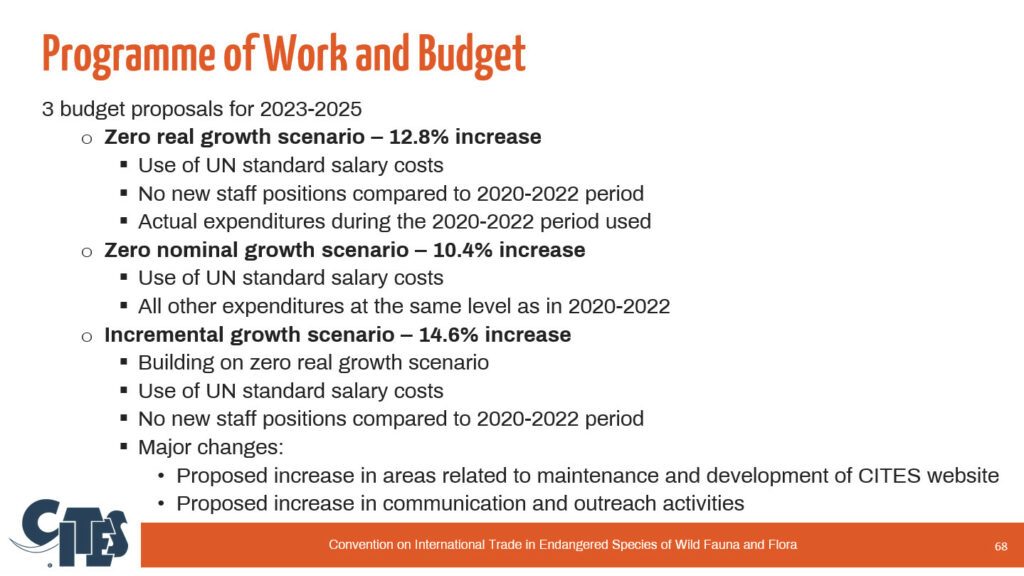
Three budget proposals
12.8% Increase
- CITES needs to use UN standards salary costs.
- The scenario does not include any staffing increases.
10.4% increase
- Our only increases under the zero wheel growth scenario were the actual expenditures we had during the 2022 period, and the UN standard salary costs for the zero nominal growth scenario.
- CITES is using the approved budget for 2022 plus the UN status salary costs.
14.6% Increase
- The incremental growth scenario is known as the Secretary General’s proposal, based on the zero real growth scenario using standard UN salaries, no new staff positions, but some changes. Maintenance and development of the CITES’s website have increased in costs.
- Staying in contact with parties has also been of paramount importance during this time of the pandemic.
CITES CoP19 – Your questions answered
Closing
Video
Highlights
Photo Gallery
Documents
Links
Past GEN Event
- Briefing on the 74th meeting of the CITES Standing Committee | 21 February 2022
- GENeva Environment Dialogues | CITES and its Upcoming Committee Meetings | 5 May 2020
- Briefing on the 18th meeting of the Conference of the Parties to CITES | 10 July 2019
- Briefing on the 70th meeting of the CITES Standing Committee | 21 February 2018
- Briefing on CITES CoP17 | 14 September 2017
- Briefing on the 66th meeting of the CITES Standing Committee | 4 December 2015
- CITES CoP 16 Debriefing | 2 May 2013
- CITES CoP 16 Briefing to the Permanent Missions and NGOs in Geneva | 15 February 2013

